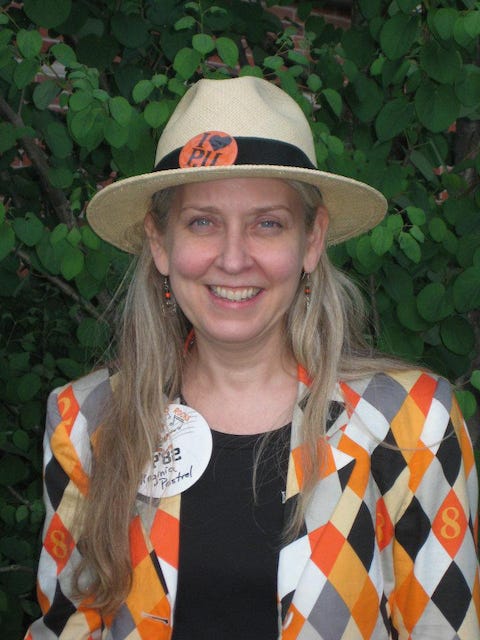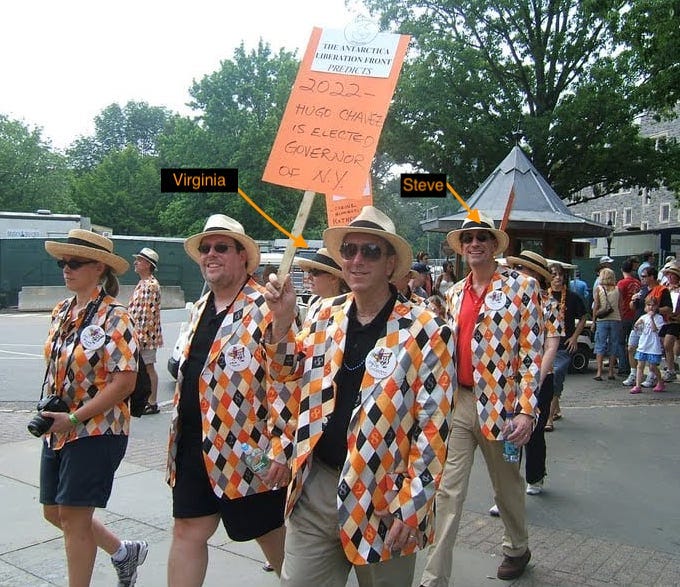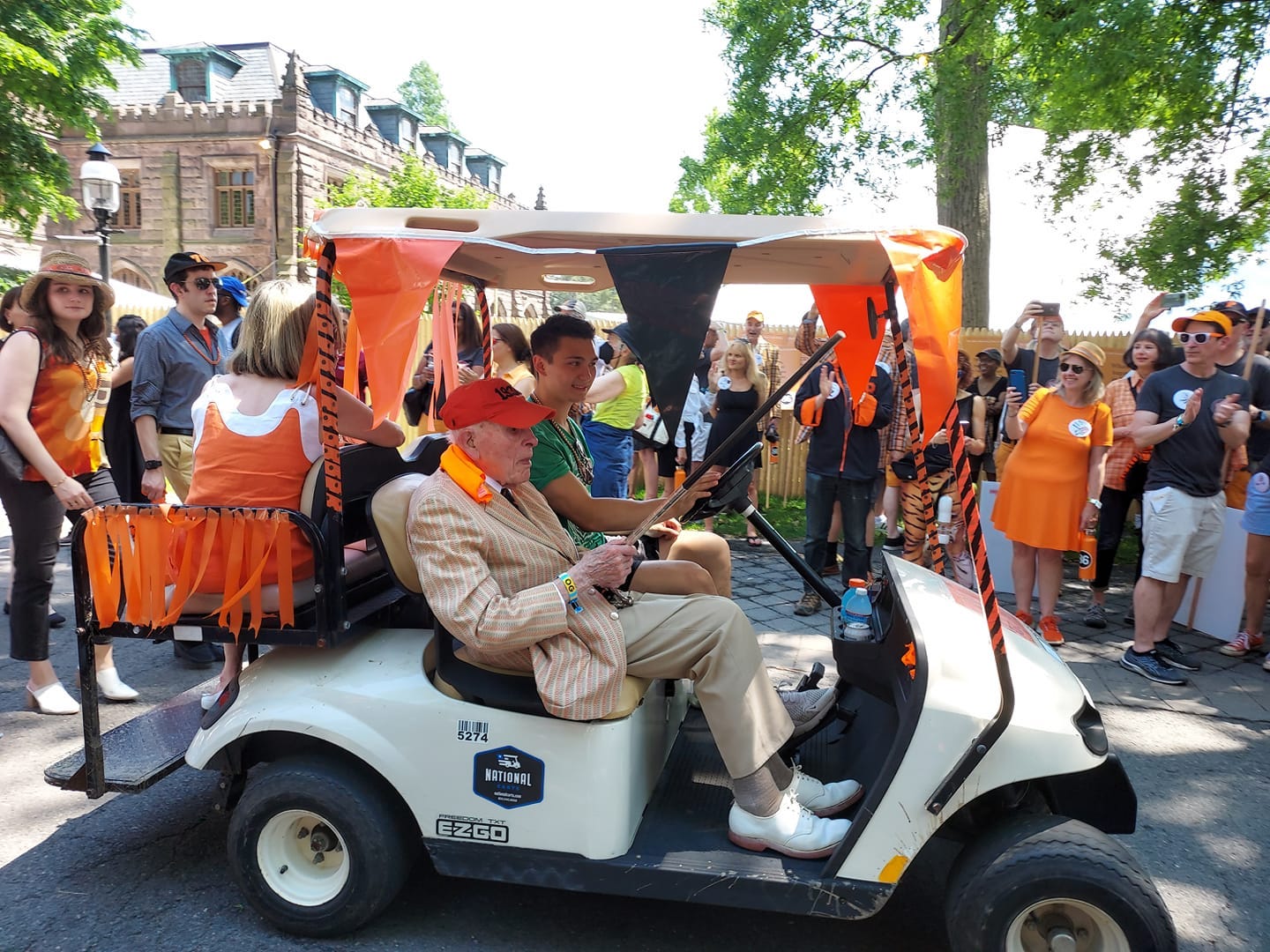Continuity and Change, with Garish Costumes
This post went out to subscribers to my Substack newsletter on May 23. To see all the entries and subscribe, visit it here.
Contrary to the promises in earlier newsletters, I can’t provide new pictures of the Postrels in our garish Princeton Reunions gear. The best I can do are a couple of shots from ten years ago.
We didn’t make it to our 40th Reunion because my favorite classmate suffered a minor but extremely painful tear in his calf muscle while innocently throwing a blanket onto the bed. Flying cross-country for several days of intense standing and walking (not to mention dancing) wasn’t going to happen.
So instead of going to Reunions, I used the occasion to think about how their peculiar rituals connect past, present, and future, embodying both continuity and change. The result was my latest column for Bloomberg Opinion.
Princeton’s rituals enact the conviction that the Princeton of today descends from the Princeton of yesterday, that the many eras of Princeton belong to one another, and that, whatever their differences and flaws, they are all beloved and good. We are here because they were here first, and they take pride and pleasure in their successors. It’s the kind of myth easily discarded yet desperately needed in our divided culture.
Among the many problems posed by current purity crusades on campuses (including an appalling one that gets a brief mention toward the end of my column) is the threat they pose to the social convention that treats all alumni as part of the family. If you’re purging tenured faculty for getting on the wrong side of political controversies, what are you saying to alums who take the same positions?
There’s an ungated version of the article here, courtesy of my Washington Post subscription, but it doesn’t include links or the great photo that accompanies the original Bloomberg Opinion version.
Thanks to my classmate Joyce Robbins, however, I can share this photo of Joe Schein ’37, the oldest returning alum at 107. Schein, a retired psychiatrist, was one of 11 Jewish students in his class, and this February Daily Princetonian article about early Jewish life on campus—contrary to myth, it didn’t start with Einstein—quotes him extensively.
Something about Princeton gets me thinking about how institutions maintain their identities as they evolve over time. One fall, at least a decade ago, I was in Princeton on a research trip. Walking through campus, I was struck by the juxtaposition of the statue of John Witherspoon, which faces the university’s magnificent neo-Gothic chapel, and a sign advertising an upcoming Diwali service. Witherspoon, a Scottish Presbyterian minister, was an important early president of the College of New Jersey and a signer of the Declaration of Independence. Although he was progressive for his day (he even encouraged students to read the infidel David Hume), he would likely have been shocked by the Medievalist Catholic style of the chapel, never mind celebrating a Hindu festival! None of these things belonged together—and yet they absolutely did.
Speaking of universities
Since August, I’ve been a Visiting Fellow at the Smith Institute for Political Economy and Philosophy at Chapman University in Orange, California. One of the institute’s signatures is the Humanomics program, which offers classes combining economics and the humanities. I taught one this year called “Consumerism and Its Discontents” and am working on a syllabus for a fall first-year seminar called “Ambition and the Meanings of Success,” in both cases teaching with an economist colleague. To explain the program to prospective students, I also produced this video.
“Consumerism and Its Discontents,” which had been previously taught in 2018, assigns my 2003 book The Substance of Style. “When I was in college,I once wrote a paper saying that my professor’s book was wrong. I told all the students, “He graded me fairly, and if you write a paper saying my book is wrong, I’ll do the same thing.” We aren’t in the business of indoctrination. We want our students to think.
I’m delighted to be part of this excellent program. Drawing students from all classes and a wide variety of majors, the courses offer a rare combination of intellectual engagement, respectful conversation, and mind-expanding works. Plus lots of feedback, from two professors.
What I’ve been “reading”
Driving between L.A. and Orange gives me plenty of time for listening to audio books, which I also enjoy while walking, cooking, and weaving. For some reason, I’m drawn to massive histories as audio experiences. I’m currently on the third volume of Simon Schama’s History of Britain. I’ve added the printed versions to my collection so I can check passages of interest (and perhaps eventually read the hard copies myself). I did the same with Ritchie Robertson’s The Enlightenment, which I first saw in a bookshop on a July visit to Princeton. I would have bought it then, but it was much too big to carry home.
If you’re looking for a non-massive history book, The Fabric of Civilization is also available as an audio book. (That’s the Amazon/Audible link, but it’s on all platforms.)


